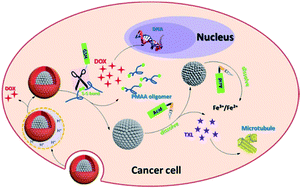Development of a redox/pH dual stimuli-responsive MSP@P(MAA-Cy) drug delivery system for programmed release of anticancer drugs in tumour cells
Abstract
Intelligent nanomaterials that are able to respond to environmental stimuli for sequential release of multiple payloads are highly desirable in applications of drug delivery systems. In this study, a core/shell-structured nanocarrier with an acid-dissolvable magnetic supraparticle (MSP) as core and a redox-degradable poly(methylacrylic acid-co-N,N-bis(acryloyl)cystamine) (P(MAA-Cy)) as shell was prepared using the distillation-precipitation polymerization technique, in which the magnetic core and the polymer shell were loaded with different guest molecules. Under physiological conditions similar to the cytoplasm of tumour cells, this MSP@P(MAA-Cy) microsphere showed a sequential degradation profile of the shell and the core. With dyes of fluorescein isothiocyanate (FITC) loaded in the core and rhodamine in the shell, the produced MSP-FITC@P(MAA-Cy)-Rho microspheres were applied in HeLa cell and HEK 293T cell cultures, showing selective degradation of the microspheres in HeLa cells to release the rhodamine and FITC dyes in sequence. When two anticancer drugs, i.e., paclitaxel (TXL) and doxorubicin (DOX), were loaded separately into the core and the shell domains of the microspheres, the experimental results showed that the MSP-TXL@P(MAA-Cy)-DOX nanodrug exhibited better inhibitive efficacy than the free drugs under the same dosing level, demonstrating the great potential of this stimuli-sensitive drug delivery system for programmed and stimuli-responsive drug release characteristics.


 Please wait while we load your content...
Please wait while we load your content...